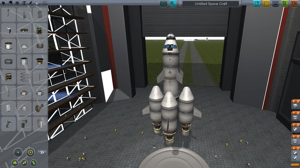A couple weeks ago I had this crazy idea for a four-week project to do with my AP-C students after their AP exams. Typically we embark on a number of individualized, small-team projects, coupled with a study of semiconductor physics. This year, however, I wanted to change it up. I want to build excitement for the sciences and engineering. I want to try and truly capture the kids’ interest. So, taking a lead from a physics teacher tweet, I began exploring the Kerbal Space Program.
I first wrote about some basic ideas around the program last week in Kerbals in Space? Gamifying the Physics of Space Exploration. Since then, with the help and guidance of a variety of folks ranging from our school’s IT experts all the way to Kerbal Space Program enthusiasts from around the world, I think we have a pilot program (pun intended) ready to launch (pun still intended). As we blast into this new foray, my larger goal is to explore whether something as simple as the Kerbal Space Program or other “gamified” simulation has the potential for implementation earlier in the K-12 curriculum. If it works with seniors, could it be used with juniors? With freshman? With junior high students? With 5th and 6th graders? All with the ultimate goal of launching students into the challenge and excitement available in STEM disciplines.
We need to grab the attention of our up and coming society at an early age, and allow them to observe the need for math, science, writing, communication, and technology, and how these skills open doorways for them to engage in such fun and challenging activities. There are tons of good programs out there promoting interest in STEM, from robotics programs to alternative fuel teams to green teams… I’m hoping the excitement of space, presented in such a fun way, allows students to reach some key conclusions on their own. First, just playing the sim is fun. For a while. Then you realize no matter what you do you tend to crash into things and can’t make it to any moons or planets. It’s time to pull out paper, pencil, calculator, and jump on the Kerbal WIKI to do some research and learn about dynamics, energy, transfer orbits, staging, etc. In this way, the students themselves are driving their own learning with a purpose, a pull system, so to speak, as opposed to pushing information out to them and then asking them to apply what they’ve learned.
It’ll be a fun experiment. I’ve completed the Kerbal Space Program Education Project definition page. We’ll see how it goes from here, and if anyone wants to join us on this exploration, we’d love to have you along!


